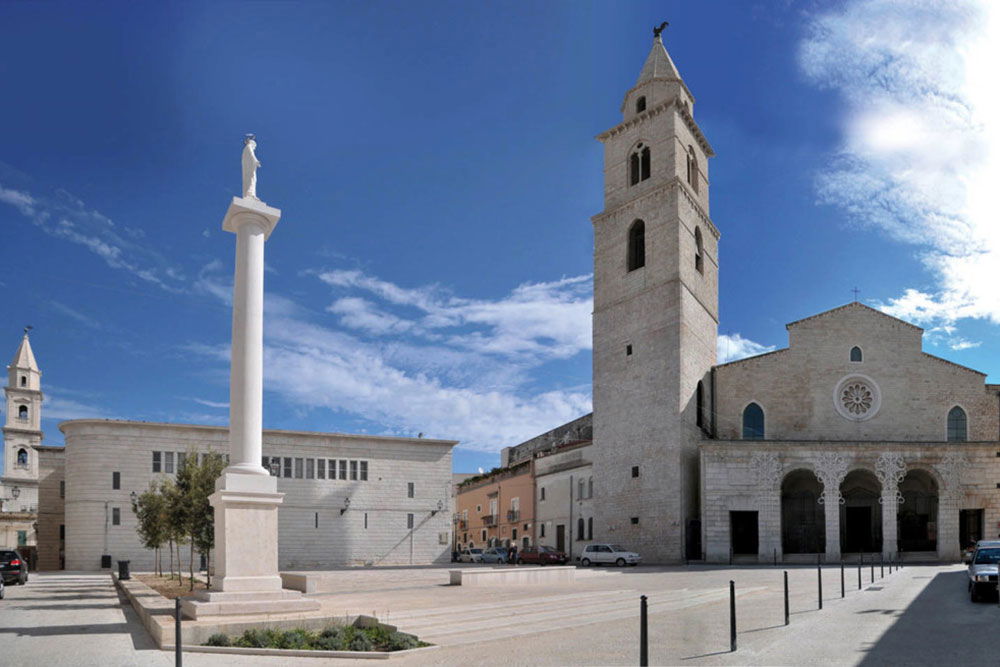
In the sun-baked heart of northern Puglia, away from the busy coastline, lies Andria, a city of ancient roots, imperial dreams, and rich agricultural bounty. Overshadowed by more famous neighbors like Bari or Lecce, Andria is one of Puglia’s best-kept secrets, steeped in history, crowned by a legendary castle, and surrounded by endless olive groves.
Andria’s origins date back to pre-Roman times, but it rose to prominence in the Middle Ages, especially under the rule of Frederick II, the Swabian Holy Roman Emperor known as Stupor Mundi (Wonder of the World). A lover of science, art, and architecture, Frederick made Andria one of his preferred residences and left behind an enduring symbol: Castel del Monte.
Beyond imperial footprints, Andria was also a spiritual hub. Several monastic orders built churches and monasteries here, giving the city an ecclesiastical charm still felt today in its many stone sanctuaries, quiet cloisters, and processional traditions.
Without a doubt, Andria’s most famous attraction is the UNESCO-listed Castel del Monte, perched on a remote hill just outside the city. This enigmatic octagonal fortress, built by Frederick II in the 13th century, is one of Europe’s most unique castles. Perfectly symmetrical, steeped in mathematical and astronomical symbolism, and still shrouded in mystery, it is a masterpiece of medieval architecture.
Unlike traditional castles, Castel del Monte lacks a moat, drawbridge, or even a military function. Scholars debate whether it was an observatory, a hunting lodge, or a temple of knowledge. Today, it offers breathtaking views over Puglia’s rolling landscape, especially stunning at sunset when the golden stone glows in the fading light.
Andria’s centro storico is a maze of narrow alleys, Baroque balconies, noble palaces, and churches. It’s wonderfully walkable and free of the tourist overload found in more coastal towns. A few must-sees include:
Cathedral of Santa Maria Assunta: A Romanesque structure with Gothic touches, built on earlier Byzantine foundations.
Church of San Domenico: A beautiful example of Puglian Baroque with elegant cloisters.
Palazzo Ducale: The former residence of the Carafa dukes, now used for exhibitions and cultural events.
Porta Sant’Andrea: A well-preserved city gate once part of the medieval walls.
Even if you’re not chasing landmarks, simply wandering the streets of Andria offers rewards, locals chatting outside cafés, artisans at work, and tiny wine bars tucked into 18th-century courtyards.
Andria is often considered the olive oil capital of Puglia, particularly famous for its production of Olio Extravergine di Oliva DOP Terra di Bari – Castel del Monte. The surrounding countryside is carpeted with olive trees, some over a thousand years old, whose fruit produces some of the finest, most flavorful olive oils in Italy.
Many local olive mills (frantoi) offer tastings and tours, where you can learn about the cold-pressing process and sample oils ranging from grassy and peppery to buttery and smooth.
Beyond olive oil, Andria is a gastronomic treasure trove. It’s the birthplace of Burrata, the world-famous cheese made from mozzarella and cream, invented here in the early 20th century. Today, you can still find artisan burrata producers who hand-twist these creamy parcels fresh every morning.
Pair that with crusty local bread, cherry tomatoes, and a glass of Nero di Troia or Bombino Nero, two excellent wines from nearby DOC zones, and you have a meal fit for royalty.
Zuppa di grano: A hearty wheat soup made with legumes and vegetables
Sfogliatella andriese: A regional variation of the beloved pastry, filled with ricotta or custard
Mostaccioli: Chocolate-glazed cookies with almond and spice, often made at Christmas
Andria’s rich cultural calendar reflects its blend of medieval grandeur and rural life. Top events include:
Federicus Festival (April): A grand medieval celebration with parades, music, costumes, and street markets in honor of Frederick II.
Madonna dell’Altomare Procession (August): A deeply spiritual event filled with candlelight and music.
Olio e Burrata Festival (various dates): A showcase of Andria’s food heritage, with tastings, cooking demos, and agricultural fairs.
The countryside around Andria offers a gentle, undulating landscape dotted with dry-stone walls, trulli, ancient masserie (farmhouses), and vineyards. It’s perfect for scenic drives, hikes, or bike tours.
Just a short trip from Andria, you can visit:
Trani: A coastal jewel with a stunning seafront cathedral
Bisceglie: A smaller seaside town with rocky beaches and authentic fishing ports
Canosa di Puglia: An archaeological treasure with Roman tombs and temples
Minervino Murge: The Balcony of Puglia, with panoramic views and prehistoric caves
Andria is a city that rewards the curious, the food-loving, the history-minded traveler. It doesn’t shout for attention, but rather draws you in with its layers of stone, of flavor, of story. It’s ideal for those who want to go beyond the postcard-perfect beaches and discover authentic, living Puglia, where people still honor ancient traditions and welcome visitors with genuine warmth.
From the mathematical majesty of Castel del Monte to the creamy perfection of burrata, from olive groves stretching to the horizon to festivals that light up medieval squares, Andria offers an unforgettable blend of culture, cuisine, and quiet beauty.

More Details



